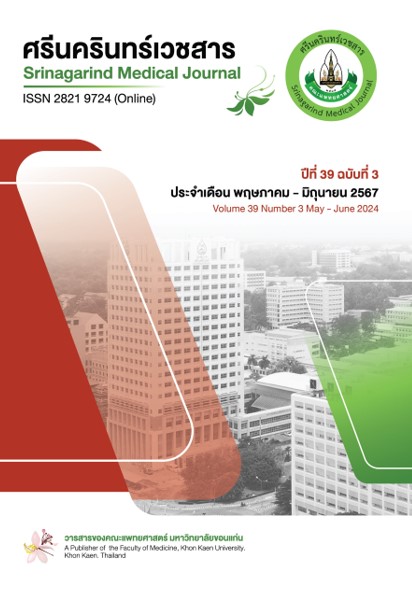ผลของการใช้ยาอิโตมิเดทเป็นยานำสลบในการใส่ท่อช่วยหายใจแบบฉุกเฉินต่อการเกิดภาวะความดันโลหิตต่ำหลังการใส่ท่อช่วยหายใจในผู้ป่วยสูงอายุ
คำสำคัญ:
ผู้สูงอายุ, การใส่ท่อช่วยหายใจแบบฉุกเฉิน, ห้องฉุกเฉิน, อิโตมิเดท, ความดันโลหิตต่ำหลังใส่ท่อช่วยหายใจบทคัดย่อ
หลักการและวัตถุประสงค์: การใส่ท่อช่วยหายใจแบบฉุกเฉินเป็นการรักษาเพื่อช่วยชีวิตที่พบได้บ่อยในห้องฉุกเฉิน ในปัจจุบันการทำหัตถการดังกล่าวด้วยวิธีการใส่ท่อช่วยหายใจชนิดรวดเร็วถือเป็นวิธีมาตรฐาน ซึ่งยานำสลบที่มักถูกนำมาใช้คือยาอิโตมิเดท เนื่องจากมีผลต่อระบบไหลเวียนโลหิตค่อนข้างน้อยและมีระยะเวลาในการออกฤทธิ์สั้น อย่างไรก็ตามปัจจุบันมีการศึกษาเกี่ยวกับผลข้างเคียงของยาอิโตมิเดทในกลุ่มผู้ป่วยสูงอายุค่อนข้างจำกัด วัตถุประสงค์ของการศึกษานี้จึงต้องการศึกษาผลของการใช้ยาอิโตมิเดทในการใส่ท่อช่วยหายใจแบบฉุกเฉินในผู้สูงอายุต่อการเกิดภาวะความดันโลหิตต่ำหลังใส่ท่อช่วยหายใจ
วิธีการศึกษา: การศึกษานี้เป็นการศึกษาแบบย้อนหลังในผู้ป่วยสูงอายุที่ได้รับการใส่ท่อช่วยหายใจแบบฉุกเฉินในห้องฉุกเฉิน ผู้ป่วยถูกแบ่งเป็นกลุ่มที่ได้รับยาอิโตมิเดท และกลุ่มที่ไม่ได้รับยาอิโตมิเดทตามชนิดของยาที่ใช้ในการนำสลบ โดยผลลัพธ์หลักของงานวิจัยคือการเกิดภาวะความดันโลหิตต่ำหลังใส่ท่อช่วยหายใจ และผลลัพธ์รองคือการเริ่มหรือการเพิ่มปริมาณยาตีบหลอดเลือดที่ใช้ภายใน 24 ชั่วโมง การเริ่มการใช้ยาไฮโดรคอร์ติโซนภายใน 24 ชั่วโมง และการเสียชีวิตในโรงพยาบาล
ผลการศึกษา: มีผู้ป่วยในการศึกษาทั้งสิ้น 231 ราย โดยแบ่งเป็นกลุ่มผู้ป่วยในกลุ่มที่ได้รับยาอิโตมิเดท 118 และ 113 รายในกลุ่มที่ไม่ได้รับยาอิโตมิเดท มีผู้ป่วย 29 รายในผู้ป่วยกลุ่มที่ได้รับยาอิโตมิเดท และ 18 รายในกลุ่มที่ไม่ได้รับยาอิโตมิเดทเกิดภาวะะความดันโลหิตต่ำหลังใส่ท่อช่วยหายใจ จากการวิเคราะห์โดยการถดถอยโลจีสติกไม่พบความสัมพันธ์อย่างมีนัยสำคัญทางสถิติของการใช้ยาอิโตมิเดทและการเกิดภาวะความดันโลหิตต่ำหลังใส่ท่อช่วยหายใจในผู้สูงอายุ adjusted odds ratio (AOR) 2.10 (0.94-2.71) p=0.070 อย่างไรก็ตามพบว่าการใช้ยาอิโตมิเดทมีความสัมพันธ์กับ การเริ่มหรือการเพิ่มปริมาณยาตีบหลอดเลือดที่ใช้ภายใน 24 ชั่วโมง การเริ่มการใช้ยาไฮโดรคอร์ติโซน (hydrocortisone) ภายใน 24 ชั่วโมง และการเสียชีวิตในโรงพยาบาล
สรุป: การศึกษานี้ไม่พบความสัมพันธ์อย่างมีนัยสำคัญทางสถิติของการใช้ยาอิโตมิเดทและการเกิดภาวะความดันโลหิตต่ำหลังการใส่ท่อช่วยหายใจแต่พบว่ามีความสัมพันธ์กับการเริ่มหรือการเพิ่มปริมาณยาตีบหลอดเลือดที่ใช้ภายใน 24 ชั่วโมง การเริ่มการใช้ยาไฮโดรคอร์ติโซนภายใน 24 ชั่วโมง และการเสียชีวิตในโรงพยาบาลในผู้ป่วยสูงอายุ
เอกสารอ้างอิง
Mohr NM, Pape SG, Runde D, Kaji AH, Walls RM, Brown III CA. Etomidate use is associated with less hypotension than ketamine for emergency department sepsis intubations: a NEAR cohort study. Acad Emerg Med 2020;27(11):1140-9. doi:10.1111/acem.14070.
Wagner RL, White PF, Kan PB, Rosenthal MH, Feldman D. Inhibition of adrenal steroidogenesis by the anesthetic etomidate. N Engl J Med 1984;310(22):1415-21. doi:10.1056/NEJM198405313102202.
Abou Arab O, Fischer MO, Carpentier A, Beyls C, Huette P, Hchikat A, et al. Etomidate-induced hypotension: a pathophysiological approach using arterial elastance. Anaesth Crit Care Pain Med 2019;38(4):347-52. doi:10.1016/j.accpm.2018.12.006.
Acquisto NM, Mosier JM, Bittner EA, Patanwala AE, Hirsch KG, Hargwood P, et al. Society of critical care medicine clinical practice guidelines for rapid sequence intubation in the critically ill adult patient. Crit Care Med 2023;51(10):1411-30. doi:10.1097/CCM.0000000000006000.
Van Berkel MA, Exline MC, Cape KM, Ryder LP, Phillips G, Ali NA, et al. Increased incidence of clinical hypotension with etomidate compared to ketamine for intubation in septic patients: a propensity matched analysis. J Crit Care 2017;38:209-14. doi:10.1016/j.jcrc.2016.11.009.
Leou K, Mendez D, Horani G, Papagiannakis N, Jiménez Sánchez R, Mazzei D, et al. Effects of etomidate on postintubation hypotension, inflammatory markers, and mortality in critically ill patients with COVID-19: an international, multicenter, retrospective study. J Intensive Care Med 2023;38(10):922-30. doi: 10.1177/08850666231173847
Srivilaithon W, Bumrungphanithaworn A, Daorattanachai K, Limjindaporn C, Amnuaypattanapon K, Imsuwan I, et al. Clinical outcomes after a single induction dose of etomidate versus ketamine for emergency department sepsis intubation: a randomized controlled trial. Sci Rep 2023;13(1):6362. doi:10.1038/s41598-023-33679-x.
Koroki T, Kotani Y, Yaguchi T, Shibata T, Fujii M, Fresilli S, et al. Ketamine versus etomidate as an induction agent for tracheal intubation in critically ill adults: a Bayesian meta-analysis. Crit Care 2024;28(1):48. doi:10.1186/s13054-024-04831-4.
Theodosiou CA, Loeffler RE, Oglesby AJ, McKeown DW, Ray DC. Rapid sequence induction of anaesthesia in elderly patients in the emergency department. Resuscitation 2011;82(7):881-5. doi:10.1016/j.resuscitation.2011.02.025
Staheli B, Rondeau B. Anesthetic considerations in the geriatric population. StatPearls [Internet]. Treasure Island (FL): StatPearls Publishing. 2023. [cited Aug 5, 2023]. Available from: https://www.ncbi.nlm.nih.gov/books/NBK572137/
Cicero M, Graneto J. Etomidate for procedural sedation in the elderly: a retrospective comparison between age groups. Am J Emerg Med 2011;29(9):1111-6. doi:10.1016/j.ajem.2010.08.004.
Raksakietisak M, Ngamlamiad C, Duangrat T, Soontarinka S, Raksamani K. The changes in cortisol levels during cardiac surgery: a randomized double-blinded study between two induction agents etomidate and thiopentone. J Med Assoc Thai 2015;98(8):775-81.
Wang F, Yang Z, Zeng S, Gao L, Li J, Wang N. Effects of etomidate combined with dexmedetomidine on adrenocortical function in elderly patients: a double-blind randomized controlled trial. Sci Rep 2022;12(1):12296. doi:10.1038/s41598-022-16679-1.
Bernard R. Fundamentals of biostatistics. 5thed. Duxbery: Thomson learning; 2000.
Smischney NJ, Demirci O, Diedrich DA, Barbara DW, Sandefur BJ, Trivedi S, et al. Incidence of and risk factors for post-intubation hypotension in the critically ill. Med Sci Monit 2016;22:346-55. doi:10.12659/msm.895919.
Mechlin MW, Hurford WE. Emergency tracheal intubation: techniques and outcomes. Respir Care 2014;59(6):881-94. doi:10.4187/respcare.02851.
Kotani Y, Piersanti G, Maiucci G, Fresilli S, Turi S, Montanaro G, et al. Etomidate as an induction agent for endotracheal intubation in critically ill patients: a meta-analysis of randomized trials. J Crit Care 2023;77:154317. doi:10.1016/j.jcrc.2023.154317.
Foster M, Self M, Gelber A, Kennis B, Lasoff DR, Hayden SR, et al. Ketamine is not associated with more post-intubation hypotension than etomidate in patients undergoing endotracheal intubation. Am J Emerg Med 2022;61:131-6. doi:10.1016/j.ajem.2022.08.054.
April MD, Arana A, Schauer SG, Davis WT, Oliver JJ, Fantegrossi A, et al. Ketamine versus etomidate and peri-intubation hypotension: a national emergency airway registry study. Acad Emerg Med 2020;27(11):1106-15. doi:10.1111/acem.14063.
Vinclair M, Broux C, Faure P, Brun J, Genty C, Jacquot C, et al. Duration of adrenal inhibition following a single dose of etomidate in critically ill patients. Intensive Care Medicine 2008;34(4):714-9. doi:10.1007/s00134-007-0970-y.
ดาวน์โหลด
เผยแพร่แล้ว
รูปแบบการอ้างอิง
ฉบับ
ประเภทบทความ
สัญญาอนุญาต
ลิขสิทธิ์ (c) 2024 ศรีนครินทร์เวชสาร

อนุญาตภายใต้เงื่อนไข Creative Commons Attribution-NonCommercial-NoDerivatives 4.0 International License.




